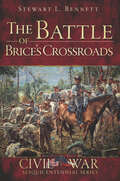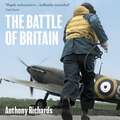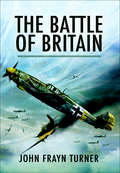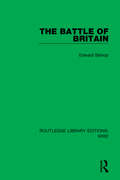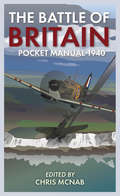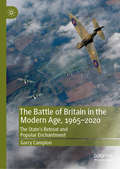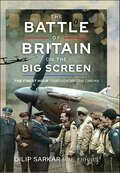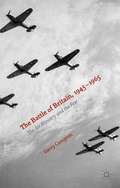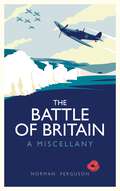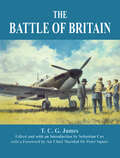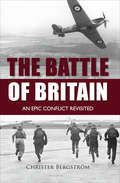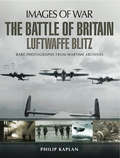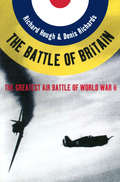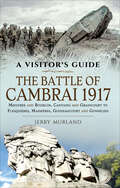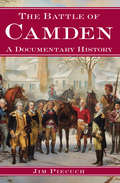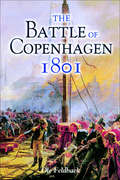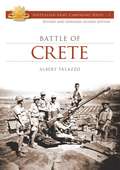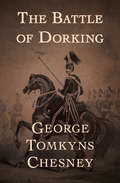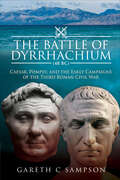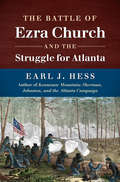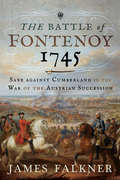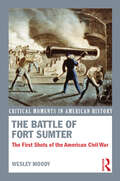- Table View
- List View
The Battle of Brice's Crossroads (Civil War Series)
by Stewart L BennettThe history of this unexpected Confederate victory in Civil War Mississippi, told through a collection of first-person soldier accounts. An insignificant crossroads in northeast Mississippi was an unlikely battleground for one of the most spectacular Confederate victories in the western theater of the Civil War. But that is where two generals determined destiny for their men. Union general Samuel D. Sturgis looked to redeem his past military record, while hard-fighting Confederate general Nathan Bedford Forrest aimed to drive the Union army out of Mississippi or die trying. In the hot June sun, their armies collided for control of north Mississippi in a story of courage, overwhelming odds, and American spirit. In this book, Stewart Bennett retells the day&’s saga through a wealth of first-person soldier accounts. Includes photos
The Battle of Britain
by Anthony RichardsIn the summer of 1940, the Nazi Blitzkrieg had blown through much of western Europe, seizing control of territory right up to the French coast and preparing to invade Britain. Standing in their way was Fighter, Bomber and Coastal Commands and the Royal Navy, all determined to prevent invasion, fighting off enemy forces in the air and in the water to protect the British shores.Published to coincide with Battle of Britain Day in 2022, this audiobook tells the heroic story of those five months using interviews, documents and materials from the archive at IWM. Personal testimony from those who were there helps bring to life this truly unique retelling of one of the most important moments of the Second World War."Hugely authoritative [...], both the iconic and the unknown, alongside brilliantly researched writing." --Dan Snow(P)2022 Headline Publishing Group Limited
The Battle of Britain
by John Frayn TurnerThe Battle of Britain was one of the crucial conflicts in the history of civilisation. It started officially on 10 July 1940 and ended on 31 October 1940. Hitlers plans for the invasion of England were thwarted by two types of fighter aircraft, the Spitfire and Hurricane, and a relative handful of young pilots, The Few.This fine book tells the momentous story of this unequal struggle, from the key events leading up to it, by graphic day-by-day accounts recording the action and commentary on the strategy. The authors personal knowledge of key figures means that there are many thrilling first-hand accounts by the aces, such as Peter Townsend, Bob Standford Tuck, Douglas Bader, Richard Hillary, Sailor Malan and other great men.This well-rounded book covers the contributions of Fighter Commands three Groups (10, 11 and 12) as well as the key roles played by RAF and WAAF groundstaff without whose tireless efforts the Battle would have been lost. A superb book which is unlikely to be bettered in its class.
The Battle of Britain
by Kate Moore The Imperial War MuseumPublished in association with the Imperial War Museum in London to celebrate the 70th anniversary of the Battle of Britain, this book brings one of the most important battles of World War II to life. Lavishly illustrated with photographs, contemporary art and propaganda posters, and accompanied by numerous first-hand accounts, The Battle of Britain captures the reality and the romance of a defining chapter in British history. Moreover, it offers a detailed analysis of the events immediately preceding the battle, the key strategic decisions by opposing commanders that altered the course of the battle, as well as the development of criticial weaponry and defenses that dramatically changed the way aerial combat was fought.Moore's book pays tribute to visionaries such as R. J. Mitchell and Air Chief Marshall Lord Dowding, who ensured that, rather than simply a victory snatched from the jaws of defeat, this was a battle for which Britain's Fighter Command was uniquely prepared. Such preparation nearly guaranteed that although the British were vastly outnumbered, they could confidently counter the German fighter planes and bombers that darkened the skies throughout the summer of 1940. It was this small band of men and women, covered in detail in this title, that were the first to successfully oppose the seemingly unstoppable tide of the Nazi war machine, irrevocably altering the course of the rest of the war.
The Battle of Britain (Routledge Library Editions: WW2 #1)
by Edward BishopThis book, first published in 1960, is a close examination of the twelve most decisive weeks in British history. It looks at the responsibility of pre-war politicians for the preparedness of the air defence system, the conflicting views on the conduct of the battle on both sides, the attitude of the US, and the part played by such leading figures as Dowding, Park, Beaverbrook, Kesselring and Sperle.
The Battle of Britain Pocket Manual 1940
by Chris McNabA guide detailing the training and operations for the British pilots, ground crew, and anti-aircraft gunners during the World War II battle.In the summer of 1940, Britain stood alone. For three long months, brave young RAF pilots took off every day, ready to defend British skies against large-scale Luftwaffe raids. “The Few” were young, but they were trained and determined. Eighty years on, the last of the pilots to fly in the Battle of Britain are feted, and their part in World War II is widely remembered.This pocket manual covers the training that these young pilots would have had, and the air combat tactics they were taught to use against the German raiders. It also covers the role of the ground crews, control and command systems, anti-aircraft defenses, and radar and raid detection.
The Battle of Britain Story (The Story Series)
by Graham PitchforkThe summer of 1940 witnessed the greatest air battle in history, as the men Winston Churchill dubbed ‘The Few’ fought over the skies of Britain to prevent the Luftwaffe from gaining air superiority, which would have paved the way for Hitler to invade our island. Graham Pitchfork charts the development of the epic battle fought by Fighter Command as it reacted to the changes in the Luftwaffe’s strategy, reaching a climax on 15 September before finally coming to a conclusion in October 1940. In addition to the exploits of the pilots in the air, the contribution of the many ground organisations that played such a crucial role is also highlighted in this lavishly illustrated book. Air Commodore Graham Pitchfork is a well-known aviation author whose previous books include The RAF Day by Day and The RAF’s First Jet Squadron: 616 (South Yorkshire).
The Battle of Britain in the Modern Age, 1965–2020: The State’s Retreat and Popular Enchantment
by Garry CampionThe Battle of Britain has held an enchanted place in British popular history and memory throughout the modern era. Its transition from history to heritage since 1965 confirms that the 1940 narrative shaped by the State has been sustained by historians, the media, popular culture, and through non-governmental heritage sites, often with financing from the National Lottery Heritage Lottery Fund. Garry Campion evaluates the Battle’s revered place in British society and its influence on national identity, considering its historiography and revisionism; the postwar lives of the Few, their leaders and memorialization; its depictions on screen and in commercial products; the RAF Museum’s Battle of Britain Hall; third-sector heritage attractions; and finally, fighter airfields, including RAF Hawkinge as a case study. A follow-up to Campion’s The Battle of Britain, 1945–1965 (Palgrave, 2015), this book offers an engaging, accessible study of the Battle’s afterlives in scholarship, memorialization, and popular culture.
The Battle of Britain on the Big Screen: ‘The Finest Hour' Through British Cinema
by Dilip SarkarDuring the Second World War, the British movie industry produced a number of films concerning the war, all of which were, by necessity, heavily myth-laden and propagandised. Foremost among these productions was The First of the Few, which was the biggest grossing film of 1942. In the immediate post-war period, to start with there were no British aviation war films. The first to be released was Angels One Five in 1952. It was well-received, confirming that the Battle of Britain was a commercial commodity. Over the next few years, many famous war heroes published their memoirs, or had books written about them, including the legless Group Captain Douglas Bader, whose story, Reach for the Sky, told by Paul Brickhill, became a best-seller in 1956. It was followed a year later by the film of the same name, which, starring Kenneth More, dominated that year’s box office. The early Battle of Britain films had tended to focus upon the story of individuals, not the bigger picture. That changed with the release of the star-studded epic Battle of Britain in 1969. Using real aircraft, the film, produced in color and on a far larger scale than had been seen on film before, was notable for its spectacular flying sequences. Between the release of Reach for the Sky and Battle of Britain, however, much had changed for modern Britain. For a variety of reasons many felt that the story of the nation’s pivotal moment in the Second World War was something best buried and forgotten. Indeed, the overall box office reaction to Battle of Britain reinforced this view – all of which might explain why it was the last big screen treatment of this topic for many years. It was during the Battle of Britain’s seventieth anniversary year that the subject returned to the nation's screens when Matthew Wightman’s docudrama First Light was first broadcast. Essentially a serialisation of Spitfire pilot Geoffrey Wellum’s best-selling memoir of the same title, Wightman cleverly combined clips of Wellum as an old man talking about the past with his new drama footage. The series is, in the opinion of the author, the best portrayal of an individual’s Battle of Britain experience to have been made. In this fascinating exploration of the Battle of Britain on the big screen, renowned historian and author Dilip Sarkar examines the popular memory and myths of each of these productions and delves into the arguments between historians and the filmmakers. Just how true to the events of the summer of 1940 are they, and how much have they added to the historical record of ‘The Finest Hour’?
The Battle of Britain, 1945–1965: The Air Ministry And The Few
by Garry CampionSeventy-five years after the Battle of Britain, the Few's role in preventing invasion continues to enjoy a revered place in popular memory. The Air Ministry were central to the Battle's valorisation. This book explores both this, and also the now forgotten 1940 Battle of the Barges mounted by RAF bombers.
The Battle of Britain: A Miscellany
by Norman FergusonHave you ever wondered...• How fast a Spitfire could travel?• Which pilot won Fighter Command’s only Victoria Cross?• What a ‘Stuka Party’ was?Telling the stories of the commanders, the air raids, the pilots, the aircraft and the vital use of the world’s first radar air defence system, this comprehensive miscellany is a compelling guide to this most crucial of Second World War battles – the first to be fought solely in the air.
The Battle of Britain: A Miscellany
by Norman FergusonHave you ever wondered...• How fast a Spitfire could travel?• Which pilot won Fighter Command’s only Victoria Cross?• What a ‘Stuka Party’ was?Telling the stories of the commanders, the air raids, the pilots, the aircraft and the vital use of the world’s first radar air defence system, this comprehensive miscellany is a compelling guide to this most crucial of Second World War battles – the first to be fought solely in the air.
The Battle of Britain: Air Defence of Great Britain, Volume II (Royal Air Force Official Histories #Vol. 2)
by T.C.G. JamesThis is the second volume of the classified history of air defence in Great Britain. Written while World War II was still being fought, the account has an analysis of the defensive tactics of Fighter Command, and attempts a day-by-day analysis of the action as it took place.
The Battle of Britain: An Epic Conflict Revisited
by Christer BergströmA thorough look at this turning-point WWII aerial battle, with eyewitness accounts, maps, and rare photos: &“incredibly well-researched&” (Aircrew Book Review). By late summer 1940, Nazi Germany had conquered all its opponents on the continent, including the British Army itself, which was forced to scramble back aboard small boats to its shores. A non-aggression pact with the Soviet Union in hand, Hitler had only one remaining object that season—the British Isles themselves. However, before he could invade, his Luftwaffe needed to wipe the Royal Air Force from the skies. History&’s first strategic military campaign conducted in the air alone was about to take place. This book contains a large number of dramatic eyewitness accounts, even as it reveals new facts that will alter common perceptions of the battle. For example, the twin-engined Messerschmitt Bf 110 was actually a good day fighter, and it performed at least as well in this role as the Bf 109 during the battle. The Luftwaffe&’s commander, Hermann Göring, performed far better than has been believed. The British night bombers played a more decisive role than previously thought; in addition, this book disproves that the German 109 pilots were in any way superior to their Hurricane or Spitfire counterparts. The author has examined records from both sides and provides surprising statistics that shatter much conventional wisdom—laying out the Battle of Britain as seldom seen before. Includes color photos of the relevant aircraft.
The Battle of Britain: Rare Photographs From Wartime Archives (Images of War)
by Philip KaplanThis new collection of archive imagery from Philip Kaplan offers a gripping, graphic view of the routine repeated each day and night, from the summer of 1940 through to the following spring, by the German bomber crews bringing their deadly cargoes to Britain. Through mainly German archival photos, it profiles airmen on their French bases and in the skies over England; the aircraft they flew, fought and sometimes died in; their leaders; their targets and results; the R.A.F pilots and aircraft that stood in opposition to the German forces, and the losses experienced on both sides. The images, from the Bundesarchiv and other German and British photographic sources, vividly convey a real sense of events as they played out, as do the compelling first-hand accounts from a host of participants on both sides, eyewitnesses to one of the most brutal sustained bombardments of the Second World War.
The Battle of Britain: The Greatest Air Battle of World War II
by Denis Richards Richard Alexander Hough<P> A definitive account of the three-month air battle in 1940 between the Royal Air Force and the Luftwaffe. <P> The victory of the Battle of Britain ranks with Marathon and the Marne as a decisive point in history. At the end of June 1940, having overrun much of Western Europe, the Nazi war leaders knew that they had to defeat the Royal Air Force Fighter Command before they could invade the British mainland. With a finely-struck balance of historical background and dramatic renderings of RAF and Luftwaffe engagements over the English countryside, Hough and Richards offer a history that is at once deep and wide-ranging. <P> They offer insight into how the British laid the groundwork for victory through aircraft research and production, the development and implementation of command and control structures, and research into new technologies, the most important of which was radar. Hough and Richards also utilize first-person accounts of the battle whenever possible, rendering the battle scenes with cinematic intensity. A compelling introduction to one of the most important battles of World War II, The Battle of Britain pays tribute to the men about whom Winston Churchill would remark, "Never in the field of human conflict was so much owed by so many to so few."
The Battle of Cambrai 1917: Mœuvres and Bourlon, Cantaing and Graincourt to Flesquières, Masnières, Gouzeaucourt and Gonnelieu
by Jerry MurlandThe 1917 Battle of Cambrai featured the first massed tank attack in military history and provoked the biggest German counter-attack against the British since 1914. The British aimed to break through the German Hindenburg Line, then threaten the rear of the German positions to the north. The battle is one of the most famous and controversial episodes of the First World War, and the battlefield is one of the most commonly visited on the Western Front. Jerry Murland’s clearly written, highly illustrated guide is the ideal introduction to it. Visitors can trace for themselves the course of the battle across the modern landscape and gain a fascinating insight into the nature of the fighting – and the wider conflict across the Western Front – throughout the war. Included are a series of routes that can be walked, cycled or driven. Among the key sites covered are Haverincourt, Flesquières, Mœuveres, Graincourt, Cantaign, Marcoing and Masnières, Bourlon, La Vacquerie and Villers-Plouich, Gouzeaucourt and Gonnelieu. In each place Jerry Murland describes the fighting that occurred there, recording what happened, exactly where it happened and why, and he points out the sights that remain for the visitor to see. His guidebook is essential reading for visitors who wish to enhance their understanding of the Battle of Cambrai and the war on the Western Front.
The Battle of Camden: A Documentary History
by Jim PiecuchFirst-person accounts and historical analyses of this dramatic Revolutionary War battle in South Carolina. On the foggy morning of August 16, 1780, American and British armies clashed in the pine woods north of Camden, South Carolina, in one of the most important and influential battles of the Revolutionary War. An American victory would quash British plans to subjugate the southern colonies and virtually guarantee the independence of the fledgling United States. A victory for the British would pave the way for the conquest of North Carolina and Virginia. After nearly an hour of frenzied, bloody combat, the British army emerged victorious, and American morale plummeted to its lowest point of the war. The rout at Camden was not a total loss, however—as Patriot forces eventually came away with a renewed determination to resist British advances, and the lessons from the defeat were applied to secure future victories that finally allowed the Patriots to triumph in the South. This book presents the Battle of Camden as never before: through the words of American and British participants and contemporary observers. The events leading up to the conflict, the combat itself, and the consequences of Camden are all described in striking detail. The cunning strategies of both American Major General Horatio Gates and British Lieutenant General Lord Cornwallis are revealed, as are a number of battlefield reports from soldiers on both sides. In addition to these compelling first-hand accounts, The Battle of Camden includes analysis of the battle and its effects in America and Europe from George Washington, Thomas Jefferson, and Lord George Germain. With this landmark text, historian Jim Piecuch offers a comprehensive consideration of a vital Revolutionary battle and its effects on the war for American independence.
The Battle of Copenhagen, 1801: Nelson's Historic Victory
by Ole FeldbaekA leading Danish historian presents a detailed account of the epic naval conflict between Denmark and a British fleet led by Vice Admiral Nelson. Fearing an alliance between Denmark and France, Britain sent a fleet of more than fifty ships to form a blockade off Great Yarmouth to prevent collaboration and ensure its naval superiority. But a series of diplomatic failures sent Vice Admiral Horatio Nelson into battle at Copenhagen. Written by the leading Danish authority on the period, this splendid work brings to life Nelson&’s historic victory immortalized by his so famously turning a blind eye to his superior&’s order to halt operations. As well as describing the brilliance of the British tactics, the work fascinatingly reveals the desperate action and great bravery displayed by the Danish defenders who suffered appallingly in the fighting.
The Battle of Crete (Australian Army Campaigns #1)
by Albert PalazzoBetween 20 May and 1 June 1941 the Second World War came to the Greek island of Crete. The Commonwealth defenders consisted of Australian, New Zealand and British refugees from the doomed Greek Campaign who had not recovered from defeat.
The Battle of Dorking: Reminiscences Of A Volunter
by George Tomkyns ChesneyBritain is under attack, and winning at Dorking is the only way the empire can be saved It is the late nineteenth century, and a country much like Germany is on the move in Europe. It has already beaten its rivals on the continent and mobilized to the Netherlands, provoking the fear of British citizens. Then the nation strikes. Its powerful weapons destroy the Royal Navy, and invasion cannot be far behind. Written as a hypothetical exercise to raise awareness among average British citizens about the potential danger that a resurgent Germany could pose, The Battle of Dorking earned its place in literary history as the forerunner to the invasion-novel genre, predating The War of the Worlds by almost twenty years. The novel&’s drama, which culminates in a fight that will change the course of history forever, thrilled audiences when it was originally released as a serial, and it maintains its power today. This ebook has been professionally proofread to ensure accuracy and readability on all devices.
The Battle of Dyrrhachium, 48 BC: Caesar, Pompey, and the Early Campaigns of the Third Roman Civil War
by Gareth C. SampsonIn 49 BC the Roman Republic collapsed once more into bloody civil war. At the heart of this war lay the two greatest living Roman commanders, and former allies, Pompey the Great and Julius Caesar, each having built their own factions within the Roman oligarchy and refusing to compromise. The subsequent civil war would be fought for control of the Republic with each man determined to restore peace and stability to Rome, under their leadership. Yet despite this clash it was eighteen months before the two men met in Battle at Dyrrhachium in Albania. Gareth Sampson outlines the strategic background, describing the early campaigns of the civil war and the factions of Caesar and Pompey that fought for control of the vast resources of the Republic. The Battle of Dyrrhachium itself is analysed to determine the strengths and weakness of both armies and their various commanders as well as the tactics used in the phases of the battle which culminated in victory for Pompey. Focus is also given to the aftermath of the battle that saw Caesar defeated and Pompey in the ascendancy.
The Battle of Ezra Church and the Struggle for Atlanta (Civil War America)
by Earl J. HessFought on July 28, 1864, the Battle of Ezra Church was a dramatic engagement during the Civil War's Atlanta Campaign. Confederate forces under John Bell Hood desperately fought to stop William T. Sherman's advancing armies as they tried to cut the last Confederate supply line into the city. Confederates under General Stephen D. Lee nearly overwhelmed the Union right flank, but Federals under General Oliver O. Howard decisively repelled every attack. After five hours of struggle, 5,000 Confederates lay dead and wounded, while only 632 Federals were lost. The result was another major step in Sherman's long effort to take Atlanta.Hess's compelling study is the first book-length account of the fighting at Ezra Church. Detailing Lee's tactical missteps and Howard's vigilant leadership, he challenges many common misconceptions about the battle. Richly narrated and drawn from an array of unpublished manuscripts and firsthand accounts, Hess's work sheds new light on the complexities and significance of this important engagement, both on and off the battlefield.
The Battle of Fontenoy 1745: Saxe against Cumberland in the War of the Austrian Succession
by James FalknerA detailed history of a pivotal, bloody battle in a clash of European dynasties, with illustrations included. The Battle of Fontenoy marked a turning point in the War of the Austrian Succession, yet it has rarely been analyzed in depth and the Europe-wide conflict in which it played a part is little understood. James Falkner, in this perceptive and original account, puts the record straight by describing the fighting in graphic detail and setting it in the context of the sequence of wars that determined the shape of Europe during the eighteenth century. Great Britain, with her Austrian and Dutch allies, fought to ensure that Maria Theresa of Austria should be able to take the throne of the Holy Roman Empire. Ranged against her interests was the might of Louis XV's France, which strove to weaken Austria by promoting a Bavarian aspirant to the Imperial throne. On May 11, 1745 at Fontenoy in the Austrian Netherlands, the two sides met in a ferocious daylong struggle that changed the course of the war. James Falkner&’s narrative gives a fascinating insight into the Battle of Fontenoy itself and more widely into the nature of warfare in Europe more than 250 years ago.
The Battle of Fort Sumter: The First Shots of the American Civil War (Critical Moments in American History)
by Wesley MoodyOn April 12, 1861, the long-simmering tensions between the American North and South exploded as Southern troops in the seceding state of South Carolina fired on the Federal forces at Fort Sumter in Charleston harbor. The battle of Fort Sumter marked the outbreak of Civil War in the United States. The attack provoked outrage in the North, consolidated support for the newly inaugurated President Lincoln, and fueled the onset of the war that would consume and reshape the country. In this concise narrative, Wesley Moody explores the long history of tensions that lead to the events at Fort Sumter, the details of the crisis and battle, the impact of Fort Sumter on the unfolding Civil War, and the battle's place in historical memory. Supplemented by primary documents including newspaper coverage, first-person accounts, letters, and government documents, and supported by a companion website, this book provides students with a nuanced understanding of both the long-term and immediate origins of the American Civil War.
